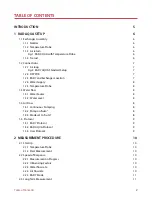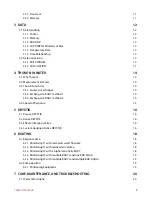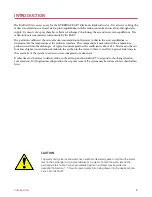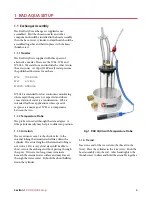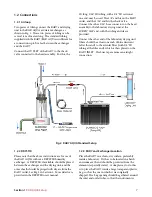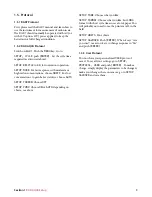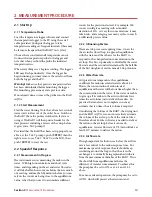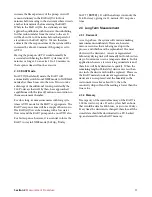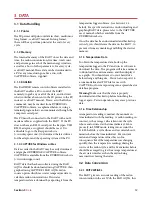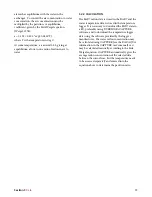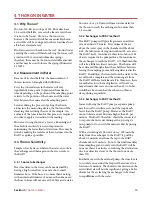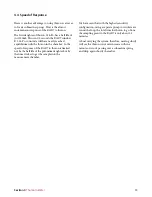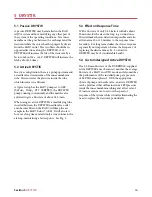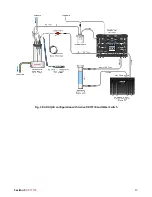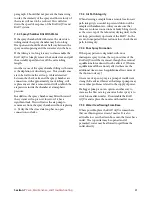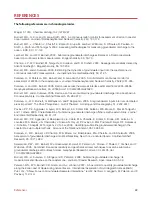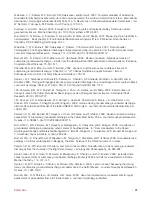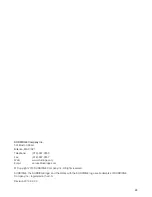
2 MEASUREMENT PROCEDURE
2.1 Start Up
2.1.1 Temperature Probe
Load the temperature logger so
ft
ware and connect
the temperature logger to the PC using the serial
cable provided. Con
fi
gure the logger to take
temperature readings at frequent intervals (these may
be far more frequent that the RAD7 test cycles.)
Choose the second (external) temperature sensor.
Connect the temperature probe to the logger and
note that when you hold the probe the indicated
temperature rises.
When everything is set, begin recording.
Th
e logger’s
LED may
fl
ash periodically. Once the logger has
begun running, you may remove the serial cord from
both the logger and the PC.
Warning!
Make sure that previous temperature data
has been downloaded before launching the logger.
Th
e launching process may erase previous data.
If not already done so, insert the probe into the RAD
AQUA.
2.1.2 Start Measurement
Start the water
fl
owing. Note that, a
ft
er a few seconds,
water starts to
fl
ow out of the outlet hose. Switch on
the RAD7 (have the printer switched on if you are
using it.
Th
e RAD7 will then print a header for the
data printout, including a review of the setup, before
it gives you a ‘Test’ prompt.)
Provided that the RAD7 has been set up properly, see
above, at the ‘
Test
’ prompt, push
[ENTER]
then the
right arrow, to see ‘
Test Start
’ on the LCD, then
push
[ENTER]
to start the test.
2.2 Speed of Response
2.2.1 Measurement in Progress
Th
e instrument is now measuring the radon in the
water. With high concentrations and short cycle
times, and depending on the air and water
fl
ow rates,
it will take half an hour or more before there is much
of a reading, and maybe
fift
y minutes before you can
rely on the count rate being close to the equilibrium
value. A
ft
er that you need to accumulate su
ffi
cient
counts for the precision desired. For example, 100
counts would give a reading with a standard
deviation of 10%. At very low concentrations, it may
take hours, and averaging over many cycles, to reach
a su
ffi
ciently precise value.
2.2.2 In
fl
uencing Factors
Th
ere are two processes requiring time. One is for
the air in the closed loop to approach equilibrium
with the water and the other is for the RAD7 to
respond to the changed radon concentration in the
air loop.
Th
e
fi
rst is primarily controlled by the water
fl
ow rate and the second is determined by the half life
of the
fi
rst daughter of radon, namely 218-polonium.
2.2.3 Water
fl
ow rate
At typical room temperature, the equilibrium
coe
ffi
cient for radon in air and water is about 4:1.
Th
at is the concentration of radon in air at
equilibrium with water will be four times higher than
the concentration in the water. If the water were able
to give up all its radon to the air it would take four
times the air volume just to deliver the radon. In
practice the transfer is not complete so we may
estimate that ten times the air volume is required.
Considering the volume of the RAD7, the drying unit
and the RAD AQUA, we can conservatively estimate
the volume of the air loop to be of the order 4 litres.
Th
erefore about 40 litres of water is needed to deliver
the radon to the air loop before it can reach
equilibrium. A water
fl
ow rate of V L/min will take at
least 40/V minutes to deliver the radon.
2.2.4 Air
fl
ow rate
Th
ough important for thoron, see below, the air
fl
ow
rate is less critical to the radon response time. For
maximum speed of response, the air should keep
circulating around the loop so that the air in the
exchanger is continually being replenished with air
from the measurement chamber of the RAD7.
Th
us
the shortfall from equilibrium and hence the
e
ffi
ciency of transfer is maximized. To achieve this
the pump may be set to ON, see 1.4.1 and 1.5.2
above.
For a more relaxed operation, the pump may be set to
AUTO, which will preserve the desiccant and
Section 2
Measurement Procedure
10


